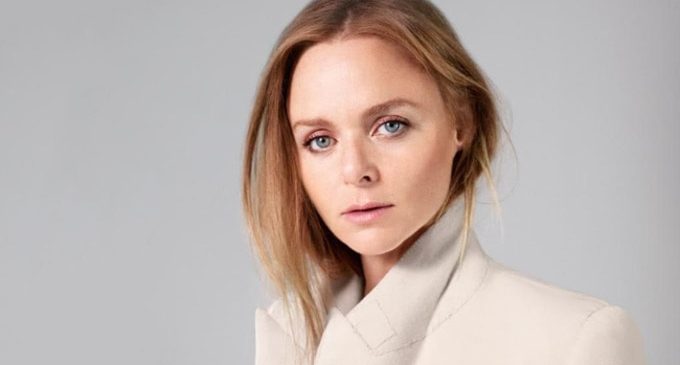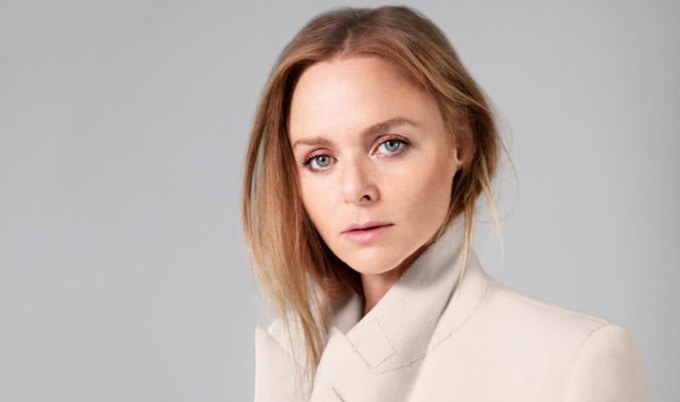Stella McCartney Responds to the Crisis: “I Want to be Completely Recycling, Completely Circular, Completely Environmental” | Vogue

Stella McCartney founded her eponymous brand in 2001. She submitted a self portrait and was interviewed for Vogue’s June/July portfolio. Her conversation with Hamish Bowles has been condensed and edited.
That’s my horse, Summer—I think there’s a level of emotional support from animals right now. It’s the place where I feel most calm and inspired when I’m riding my horse: it’s a precious, rare moment, and I’ve been able to ride more the last couple of weeks than I ever normally get to ride, so that’s my moment where I find my peace and calm. There’s so much noise in my daily life, so I don’t always see with clarity why I do what I do, not with the intensity that I do right now.
As a working parent I’ve always wanted to just be living in the country with my kids and my horse and just being a mom and everything that involves, and cooking … I’m so blessed.
It’s funny the idea of isolation, because all my friends essentially are creatives, and the majority of them are isolated every day when they work—I’m calling Urs Fisher, William Eggleston, Olafur [Eliasson], and these are all people that go into their studio and work in relative isolation.
When I think of my dad [Paul McCartney], I think of all of my musician friends, or sculptors, or musicians, or dancers, the birth of the creative moment is quite a moment of solitude, an insular moment. And I think it’s interesting for me because all of a sudden I’m getting back to the beginning of what made me want to be a fashion designer. When I was at Saint Martins, I used to sit on my own and design. And I guess the industry that we work in now relies on the rhythm of production. Now I’m finding myself getting back to that moment, the birth of it all, and it’s an interesting moment.
My company, like every other company that provides a product right now, is really having to buckle down and focus on the business and survival. I’ve got a million Zoom calls a day, and I’ve got to keep some form of structure and clarity and process in place. My headspace is in a more enclosed area. One side of me wants business as normal right now, but it would be amazing if something could come of this that had a deeper impact.
We’re all having calls with 100 people from different regions, and we didn’t do that before, and that gives me hope. Out of this, we’re connecting in a very different way, but we’re connecting in a deeper way, and certainly more globally. And I’ve been FaceTiming with so many different generations of people, reconnecting, in a sense—with William Eggleston, Sheila Hicks, Peter Blake. I do think of the older community; I think there’s hope to come of it, where we all go that little bit deeper into the meaning of life.
It’s interesting for me because my brand’s core value system is very much one of connectivity—to nature, to the fellow creatures, to the process. I’m probably one of the few fashion houses that’s been thinking this way from day one, so now, all of a sudden, to see this kind of shutdown globally, and how we’re all so connected, it’s not terribly dissimilar to how I’ve always thought, so I guess for me the hope I find is out of all of this suffering and nihilism comes an idea of connectivity, more consciousness with the consumer, some more mindfulness on how we got here, how we treat our fellow creatures, how we act in kindness, how we not just fall back into the same place.
I think that everyone wants this to have a positive change effect, and I’ve been hoping for a positive change effect for my entire career, so I have a level of hope that out of this can come something meaningful. Since I was a child, I’ve always believed in people more than the people who are in places of leadership. At an early age I was on tour, I would be in crowds of hundreds of thousands of people being affected by my parents’ music, and I’ve always had a reaction to people, the power of people uniting, and I think that this is a moment for people.
It’s not really changed the way I think, it’s just maybe made me realize the level of importance of everything I do create, and having a little more time is a massive luxury—in our industry, it’s something we don’t have. It’s moments like this that make you question what you do and why you do it, but I feel really excited that I feel we have a relevance—I’ve felt really proud of the Stella McCartney brand for having meaning and having something more to it, and that has given me a level of inspiration—having more focus on what I am creating and why I am creating it. And I’ve said to all my teams, that it would be a real disservice if we didn’t come out of this moment with a deeper level of thought as to what we do and why we make it and how we make it.
Even before I started the spring collection, before this had even happened, I decided not to buy fabric. I just want to work with all of our leftover stock and I want to be completely recycling, completely circular, completely environmental. I don’t want to order in one thing. I’ve already thought that way for many years.
So what it’s done for me on a personal level, which reflects then into my business, is it’s heightened my sensitivity to who I am and what I believe in and why I do what I do. I mean I’m a very “waste not, want not” character, and so now I’m cooking every meal and I’m feeding every mouth in the house and not one scrap has been thrown away.




There are no comments at the moment, do you want to add one?
Write a comment